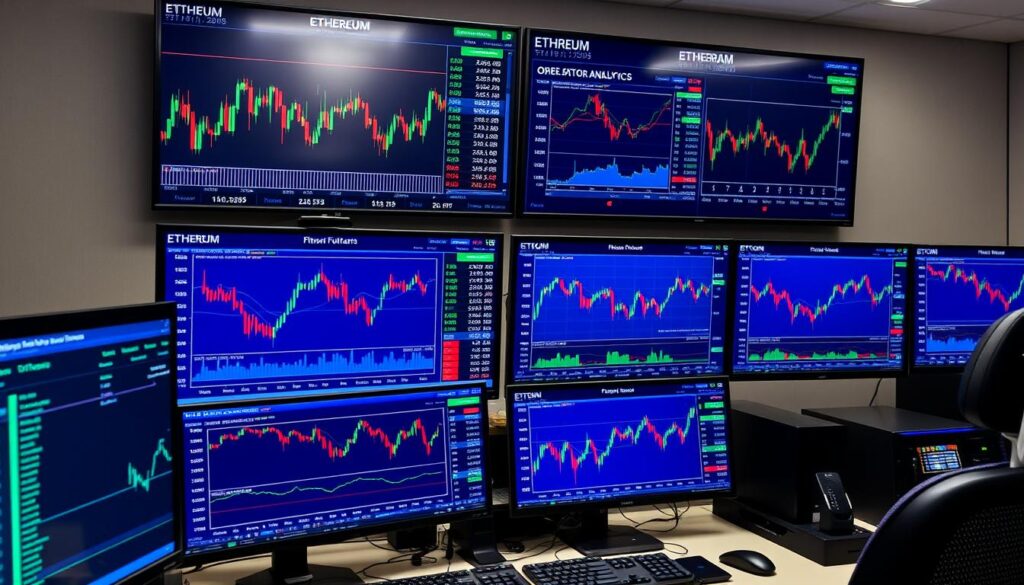Now Reading: Cryptocurrency derivatives futures options trading Explained
- 01
Cryptocurrency derivatives futures options trading Explained
Cryptocurrency derivatives futures options trading Explained

The financial landscape for digital assets has evolved far beyond simple buying and selling. New, powerful tools now allow investors to engage with markets in sophisticated ways. These instruments provide unique opportunities to manage risk and potentially enhance returns.
You can speculate on future price movements without the need to own the underlying coins or tokens directly. This opens up a world of strategic possibilities for both new and experienced market participants. Platforms like KuCoin offer access to these advanced financial products.
Understanding these tools is essential for anyone serious about participating in the modern digital economy. They offer leverage, hedging capabilities, and strategic flexibility. Mastering them can be a significant advantage in a volatile market.
This guide will provide a clear breakdown of how these powerful instruments work. We will explore their distinct characteristics and practical applications. Our goal is to equip you with the knowledge to make informed decisions in your financial strategy.
Key Takeaways
- Advanced financial tools allow for engagement with digital assets without direct ownership.
- These instruments are designed for sophisticated risk management and strategic positioning.
- They provide ways to potentially profit from both rising and falling market prices.
- Understanding leverage and margin is crucial for using these products effectively.
- Different instruments, like futures and options, serve unique strategic purposes.
- Mastering these tools can help protect your portfolio and generate income.
- Practical knowledge is key to navigating this complex aspect of the market.
Introduction to Crypto Derivatives
Today’s digital economy offers complex financial products that extend far beyond simple transactions. These advanced tools let you engage with markets in powerful new ways.
Overview and Importance
These financial contracts get their value from an underlying asset like Bitcoin or Ethereum. You don’t need to own the actual coins. This opens up strategic possibilities.
The system brings institutional-grade tools to digital markets. It improves liquidity and helps discover fair prices. Risk management becomes more sophisticated.
How Derivatives Impact Digital Asset Trading
These instruments create deeper markets with more participants. They allow traders to profit from both rising and falling prices. You can take long or short positions easily.
Advanced approaches become possible with these tools. Hedging protects your portfolio during volatile market movements. You can also generate income through various strategies.
Mastering these products is essential for modern digital finance. They represent a significant evolution in how people interact with markets.
Understanding Crypto Futures
The world of digital finance includes binding agreements that lock in prices for future transactions. These crypto futures create obligations for both buyers and sellers at a predetermined future date.

Key Features of Futures Contracts
Every futures contract has specific expiration dates and settlement methods. They can close through cash payments or asset delivery. This structure provides certainty in volatile markets.
Margin requirements are essential for entering positions. You commit collateral to control larger values. This system enables significant exposure with limited capital.
Long and Short Positions Explained
Futures trading allows participants to buy sell based on market expectations. Going long means betting on price increases. Short positions profit from declining values.
Allowing traders to speculate future price movements creates strategic flexibility. With proper risk management, traders speculate future market directions effectively. This approach works in both rising and falling conditions.
Platforms like KuCoin offer leverage up to 125x for these crypto futures. A $3,000 margin can control a $30,000 position. Successful predictions yield amplified returns on invested capital.
Exploring Crypto Options
The options market introduces a different approach to digital asset strategies, focusing on rights rather than obligations. These contracts grant buyers the ability to participate without mandatory commitments.

Options derive their value from an underlying cryptocurrency. Buyers purchase the right to transact at specific prices. This structure differs fundamentally from binding agreements.
Call and Put Options Basics
Two primary types exist: calls and put options. Call contracts allow buying at predetermined levels. Put options enable selling at established prices.
When anticipating price increases, traders purchase calls. For downward expectations, put options become strategic tools. Both instruments options provide targeted exposure to market movements.
Flexibility and Limited Loss Benefits
The key advantage lies in the flexibility options provide. Buyers can abandon positions if market conditions turn unfavorable. Maximum loss equals the premium paid initially.
This controlled risk profile helps traders manage risk effectively. The premium paid represents the total potential downside. Such certainty appeals to conservative participants.
| Feature | Call Options | Put Options | Key Benefit |
|---|---|---|---|
| Primary Use | Bet on price increases | Profit from declines | Directional flexibility |
| Maximum Risk | Premium cost only | Premium cost only | Controlled exposure |
| Right Granted | Buy at strike price | Sell at strike price | Strategic choice |
| Ideal Conditions | Bullish markets | Bearish markets | Adapt to trends |
The relationship between current price and strike price determines contract value. This dynamic creates opportunities in various market scenarios. Proper understanding enables effective portfolio management.
Comparative Analysis: Futures vs. Options
Two distinct approaches to market participation offer fundamentally different risk-reward profiles for strategic positioning. Understanding these futures options differences helps align your approach with personal goals.
Risk Profiles and Leverage
Futures create binding obligations with potentially unlimited exposure. Options provide rights without mandatory execution, capping potential losses at the premium paid.
Leverage amplifies both gains and losses in futures positions. This power also increases risk significantly during volatile periods. Proper risk management becomes essential when using margin.

Cost Structures and Trading Mechanics
Futures operate on margin deposits that must be maintained. Options require an upfront premium payment with no ongoing obligations for buyers.
Price movements affect each instrument differently. Futures track underlying values linearly. Options exhibit non-linear responses to market changes.
| Feature | Futures | Options | Key Difference |
|---|---|---|---|
| Obligation Level | Mandatory settlement | Right to exercise | Commitment requirement |
| Risk Exposure | Theoretically unlimited | Limited to premium | Loss potential |
| Cost Structure | Margin-based | Premium payment | Capital requirements |
| Leverage Effect | Direct amplification | Indirect exposure | Risk magnification |
Your selection should match your risk tolerance and market outlook. Consider how different price movements and market volatility affect each instrument’s performance.
Cryptocurrency Derivatives Futures Options Trading: Key Strategies and Benefits
Modern financial instruments provide sophisticated methods for engaging with price movements while optimizing capital efficiency. These approaches allow traders to implement complex strategies beyond simple directional bets.
Speculating Price Movements
Market participants can speculate price changes using various analytical tools. Technical indicators and fundamental analysis help traders speculate on future market directions.
Different instruments offer unique ways to capitalize market opportunities. Linear exposure works well for clear trends, while non-linear approaches suit volatile conditions.

Utilizing Premiums and Margin
Strategic capital management involves efficient use of margin and premiums. With relatively small commitments, traders can control larger positions through leverage.
This approach can amplify potential returns but also increases risk exposure. Proper position sizing becomes critical for sustainable performance.
| Strategy Type | Capital Required | Risk Level | Best For |
|---|---|---|---|
| Directional Speculation | Margin-based | High | Strong market convictions |
| Premium Collection | Premium payment | Moderate | Income generation |
| Hedging Approach | Varied requirements | Low | Portfolio protection |
| Combined Strategies | Multiple components | Customizable | Advanced trading scenarios |
Successful implementation requires understanding each instrument’s characteristics relative to the price underlying asset. Education and practice remain essential for mastering these powerful tools.
Risk Management in Crypto Derivatives Trading
The key to long-term success lies not just in profitable trades but in careful risk control. Proper risk management separates consistent performers from those who experience dramatic losses.
Understanding your personal risk tolerance helps determine appropriate strategies. Different market conditions require adjusted approaches to manage risk effectively.
Advanced tools help traders implement disciplined strategies. These automated systems prevent emotional decisions during volatile periods.
Stop-Loss and Take-Profit Techniques
Stop-loss orders automatically close positions when prices reach predetermined levels. This limits potential losses on individual trades.
Take-profit orders lock in gains by closing positions at target prices. Both tools help maintain discipline in futures trading environments.
Traders can set percentage-based stops or volatility-adjusted levels. Trailing stops move with favorable price movements to protect profits.
Effective position management requires understanding when to buy sell based on changing circumstances. These techniques work across various instrument types.
Managing Margin Requirements
Margin maintenance is crucial for leveraged positions. Each futures contract has specific margin requirements that must be monitored.
Traders should maintain buffers above minimum levels. This prevents unexpected liquidations during normal market volatility.
Position sizing based on account percentages rather than maximum leverage promotes sustainability. Continuous monitoring ensures positions remain within safe parameters.
Leveraging Perpetual Contracts for Continuous Trading
Perpetual contracts represent a significant innovation in digital asset markets by removing the traditional constraint of expiration dates. This unique feature allows traders to hold positions for as long as they wish, provided they maintain adequate margin. It provides flexibility for various strategic approaches.
Understanding Funding Mechanisms
Since these instruments have no expiry, a funding mechanism keeps their price aligned with the spot market. Periodic payments occur between long and short position holders.
When the contract trades above the spot price, longs pay shorts. The reverse happens when it trades below. This system creates incentives that naturally tether the future price to the underlying cryptocurrency.
Comparing Perpetual and Traditional Futures
The core difference lies in the expiration date. A standard futures contract has a fixed settlement date, forcing position rollovers. Perpetual crypto futures eliminate this requirement entirely.
This fundamental distinction allows traders to focus purely on market movements without managing contract cycles. It simplifies long-term strategic holds.
| Feature | Perpetual Contracts | Traditional Futures |
|---|---|---|
| Expiration Date | None | Fixed (e.g., quarterly) |
| Price Alignment | Funding rate payments | Converges at expiry |
| Position Management | Hold indefinitely | Must roll over contracts |
| Ideal for Strategy | Continuous exposure | Specific timeframes |
Successful futures trading with perpetuals requires monitoring funding rates. These costs can impact net returns over extended periods. Understanding this mechanism is key to using these tools effectively.
Trading on KuCoin: A Step-by-Step Guide
KuCoin provides a streamlined platform for entering the world of advanced digital asset strategies. This guide walks you through the essential steps to begin.
You can quickly access powerful tools for market engagement. The process is designed for both new and experienced participants.
Setting Up Your Futures and Options Accounts
Start by logging into your KuCoin account. Navigate to the dedicated sections for these advanced products.
For crypto futures, you must transfer funds like USDT to a special account. This prepares you for margin-based positions.
Enabling options requires a quick quiz to ensure understanding. You also need to agree to specific terms before funding your account with USDT for the premium paid on contracts.
Executing Trades with Confidence
Placing an order is straightforward. Select your desired contract type and trading pair, such as one to buy bitcoin.
Choose your leverage level and decide to buy sell based on your market view. This is a core part of any trading strategy.
Use stop-loss orders to manage risk. You can execute trade decisions with precision using the platform’s tools.
Understanding the nuances between different futures options is key. For a deeper comparison, explore this guide on futures and options.
This foundation prepares you for advanced trading scenarios. Always monitor your positions and the associated costs.
Hedging and Speculation: Aligning Trading Strategies
Market participants approach financial instruments with either defensive or offensive objectives. These distinct trading strategies serve different needs based on individual goals and market outlook.
Using Derivatives to Hedge Spot Market Risks
Hedging protects your existing holdings from adverse price movements. If you own Ethereum, buying put options creates insurance against value drops.
This approach secures a minimum selling price for your digital assets. The underlying asset remains protected while maintaining upside potential.
Miners often use contracts to lock in future selling prices. This guarantees profitability regardless of market volatility.
Strategies to Capitalize on Market Volatility
Speculative approaches aim to profit from price movements without holding the actual assets. You can speculate price movements using various contract types.
Sophisticated strategies profit from volatility changes themselves. These approaches capture gains from significant movements without predicting direction.
The flexibility options provide enables complex multi-leg positions. Each strategy should match your risk tolerance and market perspective.
Navigating Market Volatility and Digital Asset Price Movements
Navigating price fluctuations requires understanding how volatility impacts different financial instruments. Digital markets experience rapid price movements that create unique opportunities and risks.
These swings often reach 5-10% within single trading days. This level of market volatility distinguishes digital assets from traditional investments.
Insights into Price Discovery
Futures and options markets contribute significantly to price discovery. They aggregate information from diverse participants with different risk appetites.
This process helps establish fair values for the underlying cryptocurrency. Large positions often telegraph institutional sentiment before spot markets react.
Volume and open interest serve as valuable leading indicators. They provide clues about potential price movements in the price underlying cryptocurrency.
Different market conditions require adjusted approaches. Trending markets favor directional strategies, while range-bound periods benefit premium collection.
Successful navigation requires adaptive strategies that adjust position sizing and risk parameters. Understanding these futures options dynamics is essential for managing digital assets effectively during turbulent periods. For deeper insights, explore this guide on managing market turbulence.
The flexibility of these instruments is key, allowing traders to define risk exposure while capitalizing on volatility opportunities.
Conclusion
Navigating the world of sophisticated financial products requires understanding their distinct characteristics and applications. These instruments offer powerful ways to engage with markets beyond simple transactions.
Each tool serves different strategic purposes. Some provide direct exposure with leverage, while others offer defined risk parameters. Your choice should match your personal risk tolerance and market outlook.
Successful participation demands solid risk management practices. Leverage can amplify potential gains but also increases exposure. Always monitor your margin requirements carefully.
Continuous learning remains essential as markets evolve. Start with relatively small positions to build experience. Develop disciplined trading strategies that help you manage risk effectively over time.
FAQ
What are the main differences between futures and options?
Futures contracts obligate you to buy or sell an asset at a set price on a future date. Options give you the right, but not the obligation, to execute a trade. This key distinction affects risk, as futures can lead to unlimited losses, while options limit your loss to the premium paid.
How can I use these instruments to manage risk?
You can use strategies like hedging to protect your portfolio from adverse market movements. For example, buying a put option can help offset potential losses in your spot holdings if the price of the underlying asset falls, providing a crucial layer of risk management.
What does leverage mean in this context?
Leverage allows you to control a large position with a relatively small amount of capital, known as margin. While this can amplify potential profits, it also significantly increases risk, as small price movements can lead to substantial gains or losses, making it vital to understand margin requirements.
Are perpetual contracts different from traditional futures?
Yes. Traditional futures have a set expiration date, while perpetual contracts, like those on KuCoin, do not expire. They use a funding mechanism to keep their price aligned with the spot market, allowing for continuous trading without the need to roll over contracts.
What is a simple strategy for a beginner?
A straightforward approach is a long call option. You pay a premium for the right to buy an asset like Bitcoin at a specific price. Your maximum loss is limited to the premium, allowing you to speculate on upward price movements with defined, manageable risk based on your risk tolerance.
















